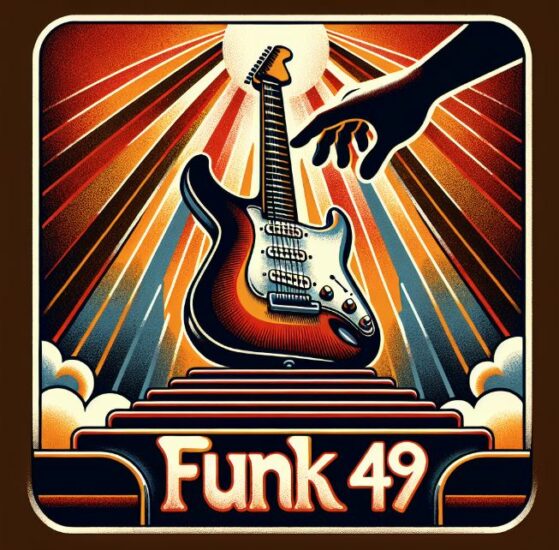“Funk 49” by the James Gang has become a classic rock staple, showcasing Joe Walsh’s guitar mastery and the band’s tight rhythm section 1 2. This guide aims to unlock the techniques and secrets behind how to play “Funk 49,” ensuring enthusiasts can replicate the iconic sound that has permeated our musical landscape 3.
From mastering the memorable intro riff to executing the dynamic solo, this article will provide a comprehensive roadmap for musicians eager to learn “Funk 49” 1. Whether a beginner or an experienced player, these insights will enhance your playing skills and appreciation for this classic track.
Understanding the Gear and Tone
To capture the essence of “Funk 49” and replicate its iconic tone, understanding the gear and settings used by Joe Walsh is crucial. Here’s a breakdown:
- Guitar and Amps:
- Electric guitar with distortion and a jazz tweed sound 4.
- Blackface Fender Champ or Vibro Champ amp 5.
- 1953-’59 Fender Telecaster, modified with a maple neck and “modern” pickup wiring 5.
- For a similar tone, use a Pro Junior IV with Volume at 8 and Tone at 5 5.
- Alternatively, a 59 Reissue Telecaster, Tomahawk by Greer Amps overdrive pedal, and an Old Silver Faced Twin Reverb amp can achieve the desired sound 6.
- Settings and Effects:
- Additional Gear for Recordings:
Understanding these gear choices and settings is a stepping stone to mastering the “Funk 49” sound. Experimenting with similar equipment and adjustments can help players come close to the tight, lemon-squeezing close-miked guitar tone that defines the track 8.
Mastering the Intro Riff
To master the intro riff of “Funk 49,” players should familiarize themselves with the unique chord shapes and techniques that give the song its distinctive sound. Here’s a step-by-step guide to nailing the intro:
- Chord Shapes and Scale:
- Techniques for the Intro Riff:
- Execute a bend-down on the G string, followed by a pull-off and a hard pick to create the iconic sound 10.
- Include blues-inspired licks with bends and pulls on the G and D strings, starting with a full step bend on the seventh fret of the B string, then a pull-off to the eighth fret of the B string 3 8.
- When revisiting the G string at the fifth fret, ensure it is pre-bent, playing the pull-off loosely to allow open strings to ring 8.
- Playing Styles:
- The riff can be played using Joe Walsh’s thumb-over-the-bass style or a bar chord style, offering versatility in approach 3.
- For the bar chord style, use an A7 bar chord at the 5th fret with the pinky off, hammering on the major third at the 6th fret on the G string 3 10 11 12.
- The “chicky chicky” part involves a D major bar chord, focusing on the D, G, and B strings, with the index finger moving to the 7th fret on these strings 3 10 11 12.
These steps, combined with dedicated practice, will help players capture the essence of the “Funk 49” intro riff, incorporating the song’s groovy feel and bluesy undertones.
FUNK 49 GUITAR LESSON YouTube Video
YouTube Video James Gang Funk #49 Guitar Lesson + Tutorial
How to play “Funk #49” on guitar by The James Gang Joe Walsh – Rhythm Guitar Lesson |
YouTube Video
Learning the Main Riff and Chords
To effectively learn the main riff and chords of “Funk 49,” understanding the blend of musical scales and techniques used is crucial. The song intricately weaves together elements of the A Mixolydian mode, derived from the D Major scale, with blues influences, creating its signature sound 9.
- Main Riff Technique:
- Start with an A7 bar chord at the 5th fret, leaving the pinky off. This forms the base of the riff 3.
- Hammer onto the major third at the 6th fret on the G string to add depth to the A7 chord 3.
- Incorporate a piece of the D major bar chord, focusing on the D, G, and B strings for a fuller sound. Hammer on the 9th fret of the D string and the 8th fret of the B string to add vibrato 3.
- Use the thumb-over-the-bass technique for a more authentic Joe Walsh sound or opt for the bar chord style for ease 3.
- Chord Progression:
- The song primarily revolves around A and D chords, with a G chord featured in the interlude, highlighting the song’s rock foundation 14.
- Between verses, the riff shifts to an A minor pentatonic scale played over an A7 chord, adding a blues flavor 9.
- Transitioning to a B minor pentatonic and concluding with an E7#9 chord creates tension, drawing listeners back to the original A Mixolydian mode 9.
- Rhythmic Elements:
By following these techniques and focusing on the key musical elements, players can capture the essence of “Funk 49,” blending rock’s power with the blues’ soulful depth.

Playing the Solo and Outro
To play the solo and outro of “Funk 49” effectively, follow these detailed steps that capture the essence of the song’s funky drum solo and wild guitar solo:
- Solo Tutorial Steps:
- Outro Tutorial Steps:
- Scale Pattern and Picking Technique:
- Start the scale pattern on the seventh fret of the D string, walk it down to the fifth fret, then move to the A string 4.
- Include the third fret, slide from three to five on the E string, and conclude with a power chord 4.
- Elevate to the ninth fret and repeat the pattern, finishing with a G minor fifth diminished chord 4.
- The picking technique for the outro involves a double pick: the first note picked with the pick and the second plucked with a finger 10.
- Notes are bent and released for a unique sound, played over a bounce back between an A7 and D chord 10.
By adhering to these steps, players can capture the distinctive funky and wild guitar solos that define the outro of “Funk 49.”
Conclusion
Through this guide, we’ve embarked on a detailed exploration of “Funk 49,” deciphering the intricate techniques and gear that contribute to its timeless appeal. From the iconic intro riff and understanding the essential gear, to mastering the main chords and the dynamic solos, musicians have been equipped with a comprehensive toolkit to not only play but deeply understand the essence of this classic track. This journey not only enhances one’s technical skills but also deepens the appreciation for the craftsmanship behind the music.
Reflecting on the broader significance, mastering “Funk 49” is more than just learning a song; it’s about connecting with a piece of musical history and embracing the spirit of rock. This guide aims to inspire musicians to strive for that authentic sound, encouraging a deeper exploration into their musical practice. As players continue to hone their skills and explore the landscape of classic rock, may the lessons from “Funk 49” serve as a beacon of inspiration, encouraging continuous growth and discovery in the vast world of music. Since there are no “People Also Ask” questions and answers provided in the input, I’m unable to create a set of FAQs. If you provide the questions and answers, I would be happy to assist you in rephrasing them into a comprehensive FAQ section.
References
[1] – https://americansongwriter.com/the-jamming-meaning-behind-funk-49-by-the-james-gang/ [2] – https://www.songfacts.com/facts/james-gang/funk-49 [3] – https://www.youtube.com/watch?v=CRfkEalJAcI [4] – https://www.youtube.com/watch?v=Xnq9MpWth4A [5] – https://www.guitarworld.com/artists/the-secrets-behind-joe-walshs-tone-on-the-james-gangs-funk-49 [6] – https://www.youtube.com/watch?v=4WLSJWoLQS4 [7] – https://www.thegearpage.net/board/index.php?threads/joe-walsh-early-gear.2170472/ [8] – https://www.youtube.com/watch?v=vvXhZqyua3A [9] – https://www.youtube.com/watch?v=X06coM2AHB4 [10] – https://www.youtube.com/watch?v=s5vAfGIjXus [11] – https://www.youtube.com/watch?v=–skyfD38Rs [12] – https://www.youtube.com/watch?v=sPtpPW4C1Hw [13] – https://tabs.ultimate-guitar.com/tab/james-gang/funk-49-chords-1668796 [14] – https://www.youtube.com/watch?v=sXr85fAge5w [15] – https://www.youtube.com/watch?v=IPHcrKW0H_8 [16] – https://www.nashvilleguitarguru.com/uncategorized/essential-riffs-funk-49/

